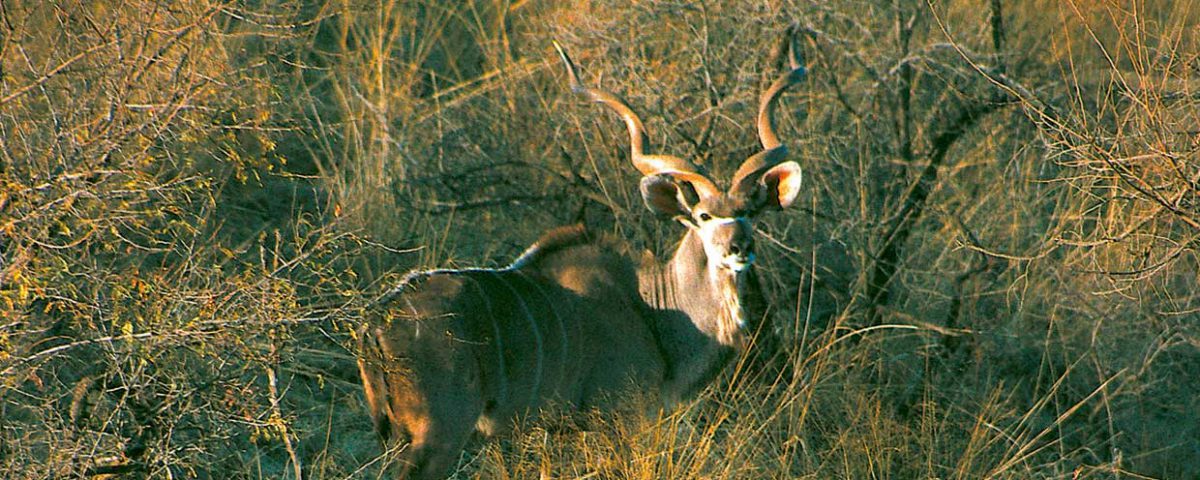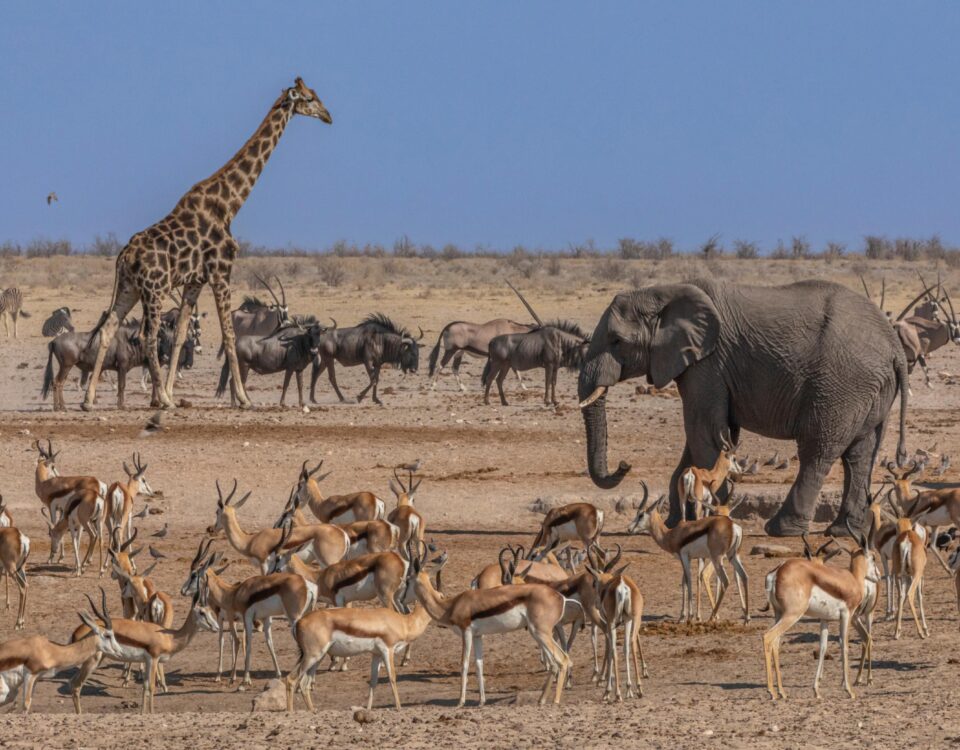| Main photo ©Helge Denker

The core of hunting
June 13, 2016
The warrior of solitude
June 14, 2016I n 1908 Dr Arthur Berger and his long-standing friends, Captain Roth and Baron von Donner, undertook an extensive hunting and research expedition to East Africa.
On their ten-month foot safari, accompanied by 100 native porters, the three Germans crossed what was then called British East Africa, the Kenya of today. Berger was successful where most safaris of the time failed. He managed to shoot a greater kudu on the Leikipia Plateau, and it was a huge bull with horns measuring 151 cm (59.5 inches) into the bargain.
Berger recounts the story in his book In Afrikas Wildkammern: “Kudu love hilly terrain (…) After a good day’s march, we reached the kudu haunts (…) our camp was at the foot of rows of gradiated hill ranges of the most loathsome feature. It seemed as if all the rubble of Africa had collected here to form these hills (…) other than the isle of Kwalö in northern Norway where I hunted reindeer, I had never crossed such difficult terrain. Here passion was really needed. Always up hills, down hills, half sliding, half falling.
The silence of death hung over the scene. The slightest sound was echoed by the cliffs. At first I had the bold idea to take a photograph of a live kudu, after three days of fruitless clambering around I gave up on that idea. I would be happy to bag a specimen of this noble animal (…) on 15 October I eventually achieved this (…) carefully we searched every hillside and every valley with our binoculars. Kudus are so well camouflaged that it is incredibly difficult to spot them. By that time I also had enough of climbing. There was only one last valley to explore. Cautiously we crawled to its rim. Suddenly my guide grabbed my arm: ‘Malo [kudu],’ he whispered. It made my heart beat faster. I could also see it. The silhouette of an animal standing in the shade contrasting against the dry backlit grass, with an impressive set of corkscrew horns on his head.
A strange animal seen from the side: its frame all like a red stag, but those strange horns! (…) now he turned his head. What a different view! A truly noble animal stood before us.
The shot rang out through the silent valley, thundering and echoing repeatedly. There was a loud thump. The stag (that is how I would like to call the male kudu) took off in a high leap (…) The bullet was well placed, the wound deadly. The mighty kudu took off, staggering slowly through the scrub. I had bagged one of the most beautiful African trophies, which I value as much as a lion or an elephant.”
Ever since hunters from the European countries for whom hunting the red stag is the pinnacle of noble pursuit of hunting, the kudu with its shy albeit majestic appearance has been compared to the red stag.
It must be justified to compare the kudu to the red stag, but it also entails a certain presumption, because Africa is so completely different from Europe, the kudu in its entire being so uncomparable that only someone with a true affection and understanding of the dark continent in its tranquillity, bizarre magnificence, dust, dryness and mirages, will fully understand the true nature of a kudu.
In Europe’s well-maintained high forests or pole woods, the kudu would certainly suffer, as it loves the wild chaos of a primordial landscape, the interwoven mayhem of thorny thickets and knobbly trees, and the rough beauty of a dry, rocky wilderness.
Here the kudu turns into an unreal, grey ghost wonderfully camouflaged, disappearing slowly as the perfect combination of elegance and dignity, the epitome of gentle beauty and grace.
Here – and for someone who, like the kudu, is at home in this pristine wilderness – the wonderful, curled horns do not appear strange, but rather the consummation of a superb creature wholly adapted to the African veld.
Dry, impenetrable bush characterises large tracts of Africa. This thorny bushveld comprises some of the roughest and hottest regions on the Dark Continent. Nothing is revealed of the friendly open savannahs, the umbrella-like acacias and the huge herds of game of the Serengeti, the Masai Mara or the Amboseli area at the foot of Kilimanjaro.
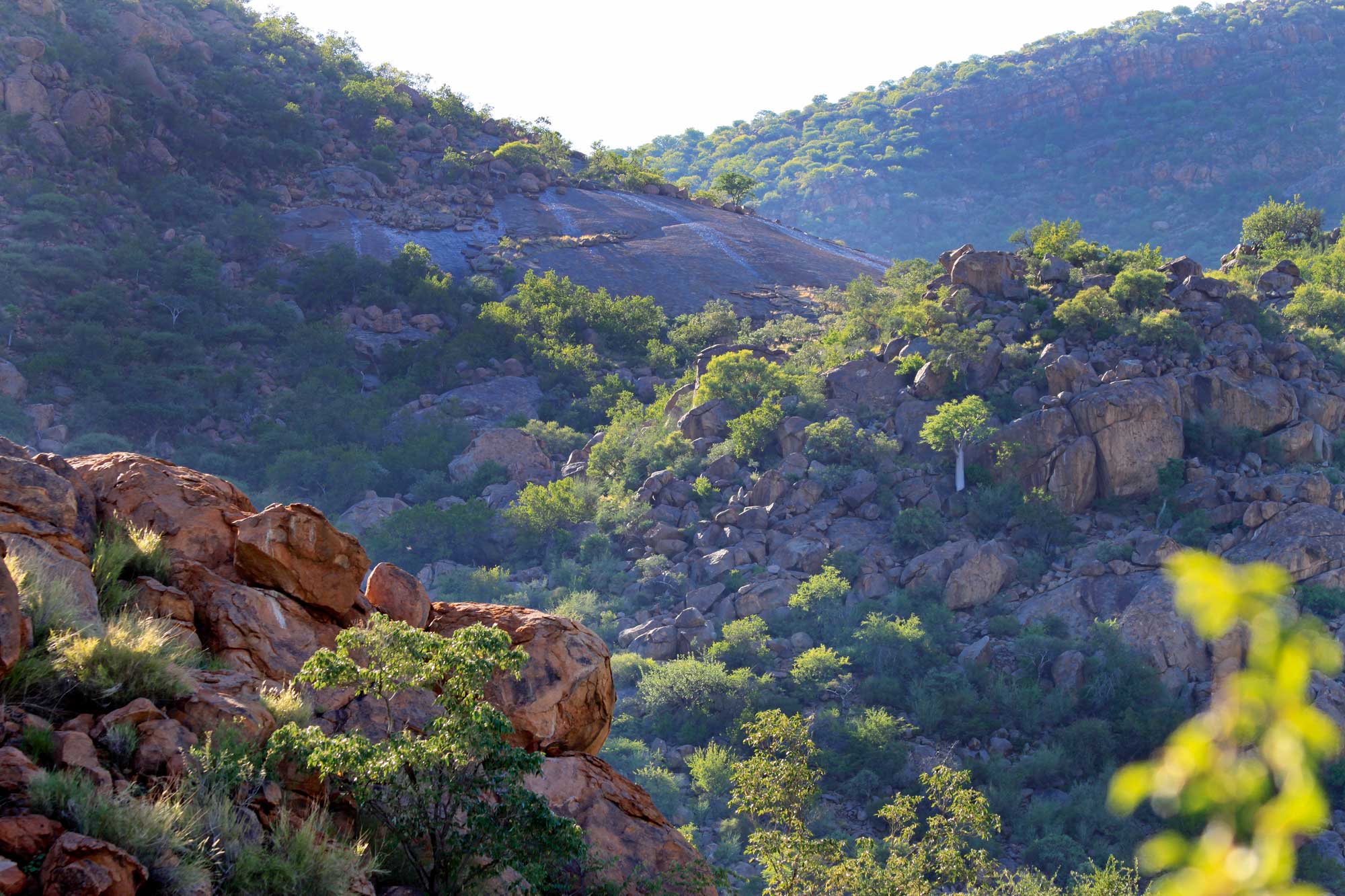
“A strange animal from the side, its body combined with those curious horns resembled a stag. He turned his head. What a different view! A truly noble animal stood before us.”
Where the bush landscapes are flat, they might appear monotonous and graceless, and because of the many thorns, even inhospitable. In other areas, where they undulate and are intersected with isolated hills or sporadic mountain ranges, they appear more attractive, and at times – when the bush expands over rocky mountains and rugged escarpments – even spectacular.
Nevertheless, especially during the dry season, the thorny bushveld, shrubs and trees appear dusty, grey and indifferent, and the stony terrain and rocky hills of large areas make walking here a torment.
But almost always a mysterious magic comes with the landscape. And this inhospitable realm of thorns is the genuine habitat of some of the most beautiful and graceful animals on our planet – the greater and lesser kudu, the gerenuk and the Damara dik-dik. It is also a great environment for birds.
Some acacia species form interwoven thickets, like the black-thorn acacia, forming an almost impenetrable, low undergrowth that appears like an extensive thorny barrier and providing protection to a manifold and striking variety of waxbill species, such as the tiny, exquisite black-faced waxbill. During the short, intensive rainy season, weavers build their distinctive nests in the spreading branches of the umbrella-thorn, and with their clamouring calls, seem to animate the bush, which suddenly turns green after lying dormant for many months of the year.
In general, the contrast between the long, dry season – which the thorny bushveld endures with equanimity and in stoic silence – and the short, intensive rainy season that rapidly transforms the steaming hot landscape, criss-crossed with dust swirls into a paradise scented with acacia blossoms and animated by chattering birds, is one of the special characteristics of this varied landscape of red termite mounds and baobab trees towering majestically over the thorny bush. It sets a unique tone in this world, which might, at first glance, appear alien to the traveller from Europe.
The bushveld extends from the Horn of Africa over areas of Ethiopia, Somalia, Kenya, Tanzania and north-eastern Uganda. The locals in East Africa call it Njika, meaning ‘wild and lonely land’. This landscape continues in the southern section of the continent, extending from south-western Angola to Namibia, Botswana, part of Zambia, Zimbabwe and into South Africa.
These two regions, separated today by the expansive Miombo Forest zone, were connected approximately 20 000 years ago when the climate in Africa was more arid. The bushveld in many areas merges into the Miombo Forest, or is intersected by open savannahs. The unique and typical aura of thorny bushveld becomes perceptible in two regions, quite distant from one another: one the legendary Northern Frontier District in Kenya, where the bleak, arid landscape is interspersed by isolated rocky mountain ranges that suddenly loom out of the bushveld and are referred to as Ol‘Donyo by the Masai. Even today, more than 30 years after the closing of trophy hunting in Kenya, regions such as Samburu and Marsabit enjoy an almost mystical fame among connoisseurs of Africa. Regions with a similar attraction are found in the Karamoja Province of Uganda or Masai country in Tanzania.
Apart from these, and although the areas never enjoyed the legendary popularity of the rough bushveld in eastern Africa, the dry reaches of Namibia holds a similiar spell and can be called Kuduland par excellence. Even in the central highlands of Namibia, although not as pristine, one can find a landscape with a charisma similiar to the famous Northern Frontier District. A mountain range like Mount Etjo, rising in majestic isolation above an ocean of thorns, could just as well be in the Samburu steppe.
And, finally, at the escarpment, where the central highland breaks away into the Namib Desert, you will find a landscape unmatched in its transcendence.
“Then the imposing animal moves on, slowly and in perfect harmony, disappearing in a play of light and shadow into a clutter of rocks and thorns. And the wild, rough landscape that became alive for a moment of perfect harmony reverts back to stoic equanimity.”
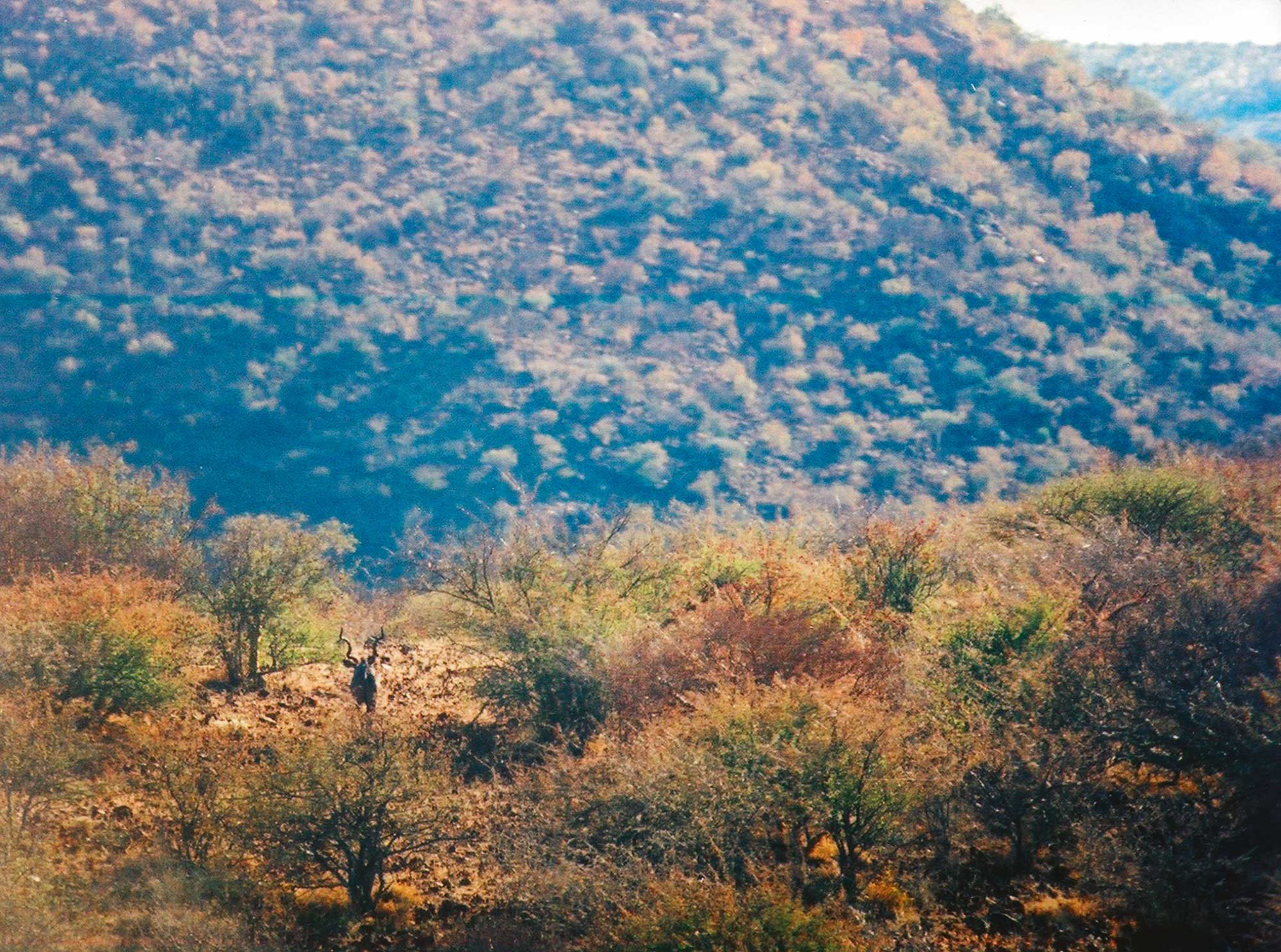
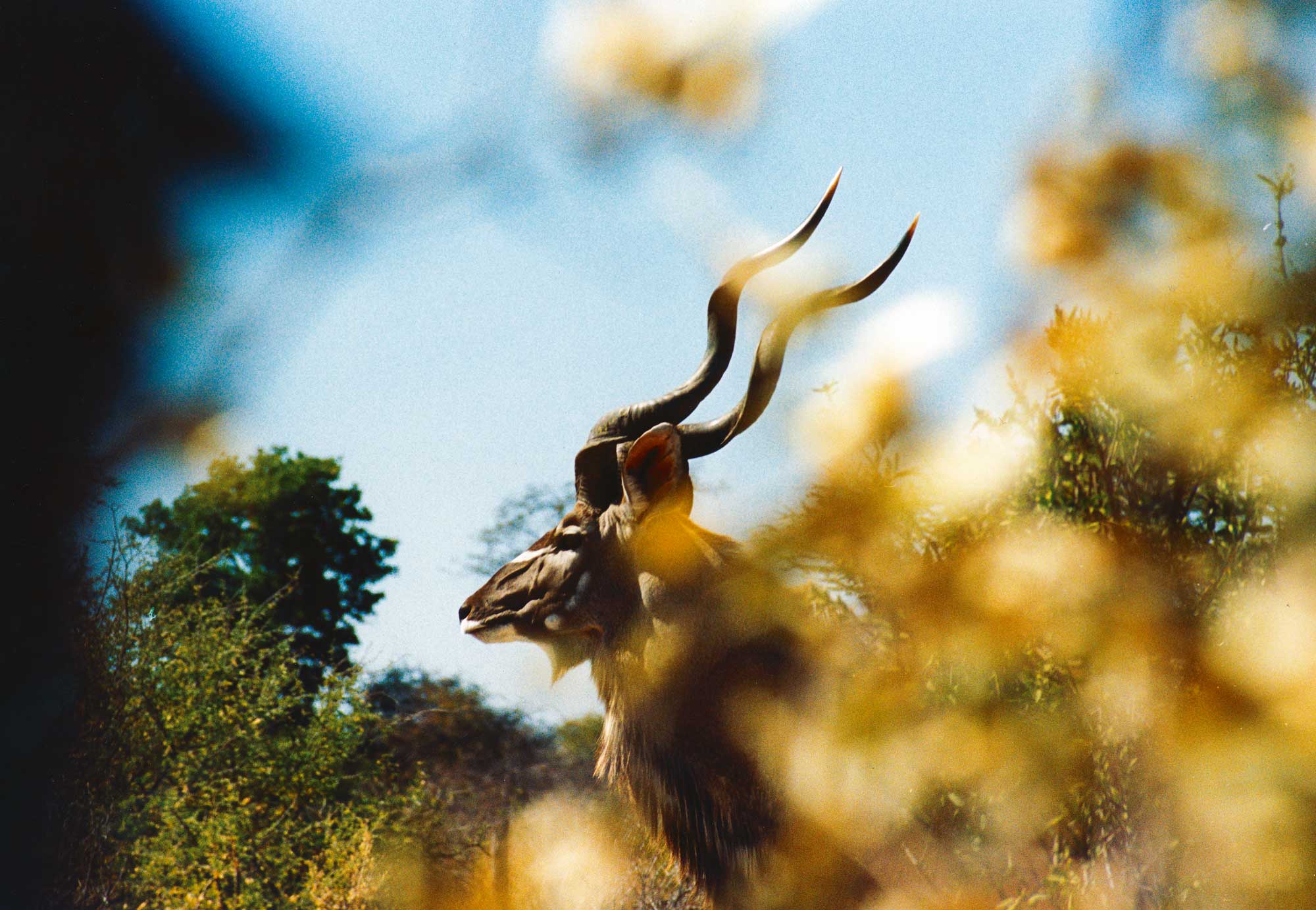
In this dry, rocky wilderness, the kudu turns into an unreal, grey ghost wonderfully camouflaged, disappearing slowly as the perfect combination of elegance and dignity, the epitome of gentle beauty and grace.
Bearing in mind that wide sections of the Namibian escarpment were at one time – as native homelands or restricted diamond areas – unreachable, it is astonishing that such a spectacular landscape, which in parts can compare to the Semien Cliffs of Ethiopia, and in size and remoteness even excel the Northern Frontier District, has attracted so little attention.
Here a hunter – who has mastered the tough climb up rocky slopes described by Arthur Berger as accumulations of all the rubble of Africa heaped together – probably inwardly cursed the harsh conditions of the terrain. But his heart, once he sits on a rock breathing freely and carefully glassing the surroundings, will swell in the face of this spectacular scenery.
He knows that the successful mastering of difficult terrain is the essence of a road worth travelling. The great tranquillity of the landscape gradually penetrates his innermost being, enhanced by calls of Senegal pigeons from the depth of the valley, the throaty rising and fading sounds made by Monteiro’s hornbills from the opposite slopes, and the shrill cries of francolins.
After long and careful glassing, an animal, admirable beyond description, suddenly appears in a space the binoculars have already scrutinised a hundred times. It appears motionlessly, looking down into the valley, the curls of its impressive horns reflecting the sunlight. The large sensitive ears are turned forward, and only the long beard down its throat moves slightly in the gentle breeze. Then the imposing animal moves on, slowly and in perfect harmony, disappearing in a play of light and shadow into a clutter of rocks and thorns. And the wild, rough landscape that became alive for a moment of perfect harmony reverts back to stoic equanimity.
After the eland, the greater kudu is the second-largest antelope. Its range extends from the wider expanses of southern and eastern Africa and even westwards along the Sahel zone into northern Chad. The most important prerequisite for its occurrence is sufficient cover and access to water. Nevertheless, the kudu can survive several days without drinking if necessary, and especially during the dry season, the bulls leave their ranges periodically for a few days to visit far-flung water points. That way the kudu, like the gemsbok, can exist in bleak, arid areas as long as there is sufficient cover in the shape of rocky slopes or thick bush.
The kudu is almost exclusively a browser. It lives temporarily in small family groups with the females and their offspring. At age three, at the latest, young bulls leave the family herd and live the life of a loner or form loose groups with other bachelors. Only during the mating season do the adult bulls rejoin the herds. While kudu are not territorial, they stay within a ranging area where a family group can frequently be found. After the mating season, the bulls retire to their own ranges, which are often located in remote mountainous regions, and alternate with the seasons.
Although not territorial, the bulls maintain a strict hierarchical order within their ranging areas. The frequently spread opinion in specialist literature that the fights among kudu are generally not serious, is incorrect. About a month before the beginning of the mating season (which takes place from May to July in Namibia) fierce and lengthy fights between the bulls take place. In this way the dominant bulls secure their mating territory and force competing bulls to migrate to other areas. At times, these fights result in fatalities due to the horns of opponents becoming irrevocably interlocked, causing both bulls to perish. It is very seldom that deadly injuries are caused by horn stabs.
During the mating season it is common for one dominant bull and several family groups to be present in an area of up to 100 hectares. The bull will now, according to the rut, move from one family group to the next, while in the surroundings several younger bulls are often present. The display patterns of the dominant bull keep those at bay when he is present. This is probably what causes the erroneous observation that among kudu, serious fighting hardly ever occurs. At the apogee of the mating season, the dominant bull cannot serve all the female groups, so during this phase, younger, immature bulls will have their opening or, with an appropriate population density of older bulls, bulls from neighbouring ranges will migrate into the area. Towards the end of or after the rut, several dominant bulls might join a family group, and fierce fights over the last females in rut will occur once again.
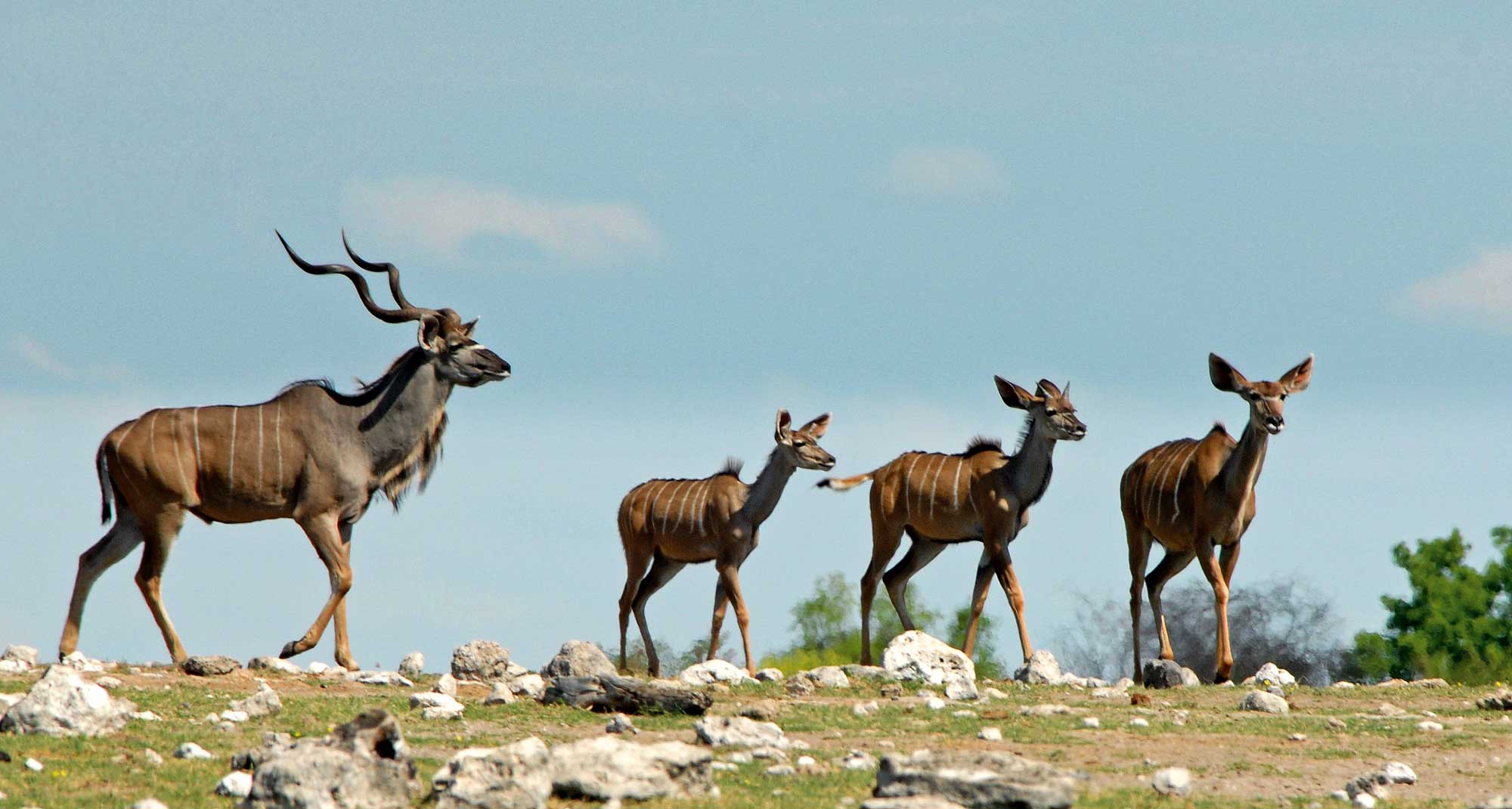
Also doubtful is the opinion expressed in some specialist books that the rut and fighting are accompanied by extensive sounds. This has yet to be recorded. Whether here the analogy to the red stag has also mislead some authors remains to be seen. In general, the mating season of the kudu is, besides the clashing of the horns during the fight, definitely silent.
However, kudus can make several sounds, such as whining and grunting, and especially a very loud and distinctive bark of alarm.
Apparently kudu are more liable to certain diseases than other antelope. For instance, at the end of the 19th century, they suffered more than other antelope from the rinderpest epidemic and, in East Africa the population never completely recovered. In Namibia, in a cycle of approximately 20 years, the kudu population has been reduced drastically by other epidemics. In addition, a mange-like disease or morbid growth on the hoofs (not caused by the biotope) that finally causes the infected kudu to die, also occurs.
These diseases are probably rooted in overpopulation caused by extensive nurture since kudus in general are highly adaptive. As these animals have excellent camouflage, their numbers tend to be underestimated, especially by casual observers.
Hunting game that frequents densely overgrown rocky terrain and whose nature is defined by camouflage may be expected to be exciting from the outset. When, furthermore, the animal is exceptionally beautiful and sublimely majestic, and its appearance is further accentuated by the rough environment, it makes for great hunting.
In general, a fair chase on kudu offers two options: wherever the biotope allows, you will occupy an elevated position that provides a good view of the area. Here you make yourself comfortable and start by carefully glassing the indistinct landscape. Patience is of the greatest importance, because the camouflage of these animals is perfect and they move in a slow and unobtrusive manner. Because of the dense vegetation, they are often completely invisible.
Several times during the hunt, a kudu bull will give its presence on the opposite slope away by its rough call of alarm because we had moved slightly when climbing up to a more promising viewpoint. Only after many hours of intensive glassing could I finally spot the old bull.
Once an old bull has been spotted, the stalk commences. At this stage the following becomes important: once you’ve clearly established the position of the bull, you have to proceed swiftly and cover as much distance as possible in a short period of time. Should the animal disappear suddenly – and this is often what happens – you need to practise extreme caution. The kudu will move a little, then pause to gauge its surroundings, staying in one spot for a while, browsing and repeatedly monitoring the landscape from its cover.
This behaviour guarantees a stalk that is nerve-wracking and makes you hold your breath. Each time you lose sight of the animal, the nail-biting starts all over again. If you’re not careful enough, you might walk right up and spook the alert animal – a loud alarm bark and the swaying tips of the horns disappearing in the bush, ends the stalk. If, on the other hand, you hold back too long, you might lose sight of the bull and it could disappear without a trace.
In the flat bush, where intensive glassing is not possible, the best option is to move cautiously, stopping and listening frequently. To find a good bull, you need to do your bush stalking early in the morning or late in the afternoon. Bulls browsing confidently often make noises while they are feeding, especially when using their horns to break off leaves and pods from branches they cannot otherwise reach.
No other hunt – not for a hundred-pounder, a Marco Polo ram, a leopard or a buffalo – has put me into this state of complete unleashed passion, holding my breath and with all my other senses alert and my heart beating wildly, like the stalk after a really big kudubull that has disappeared in thick bush.
When groping your way through thick bush in a state of high alertness, your toes tingling in anticipation, no excitement beats the thrill when suddenly the contour of a bull, its body framed by its tiny white mane, becomes visible amongst the play of light and shadow amidst a cluster of thorns, bushes and branches. And after the wild adrenaline flush, you come to an abrupt halt, and you experience the exulting notion that the bull is not aware of you. Then the bull moves on at a slow pace, with slightly swaying steps, its head and mighty neck lowered, and the magnificently curled horns swinging out far over its back.
Enthusiastic red stag hunters must please excuse me if I at this point turn the tables and fromout Africa’s perspective – that continent whose natural beauty is beyond the scope of conventional notion – and state that the red stag in some aspects of its stately majestic appearance is not unlike that of the unique Greater Kudu.
This article was first published in the HUNTiNAMIBIA 2014 issue.

